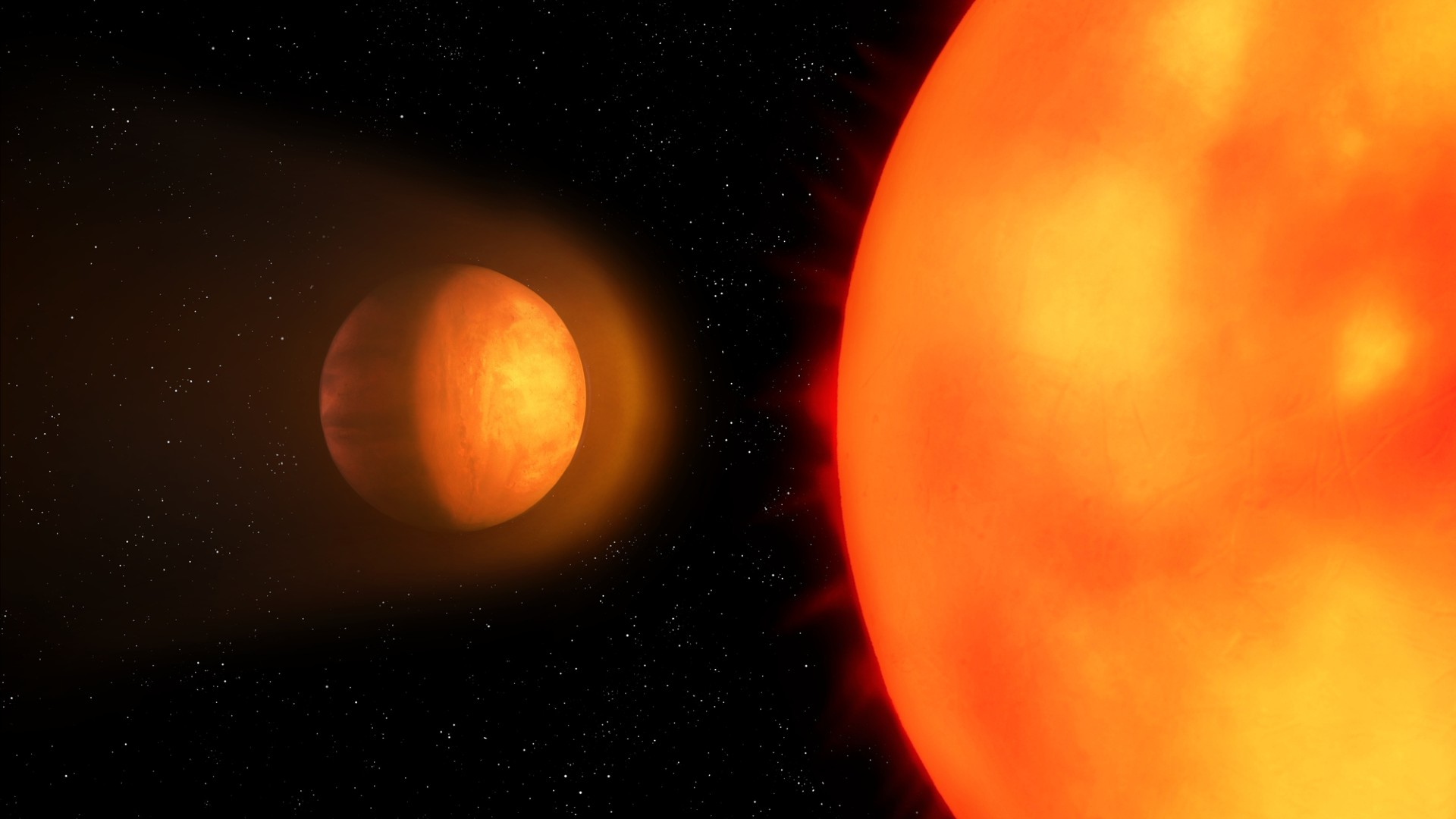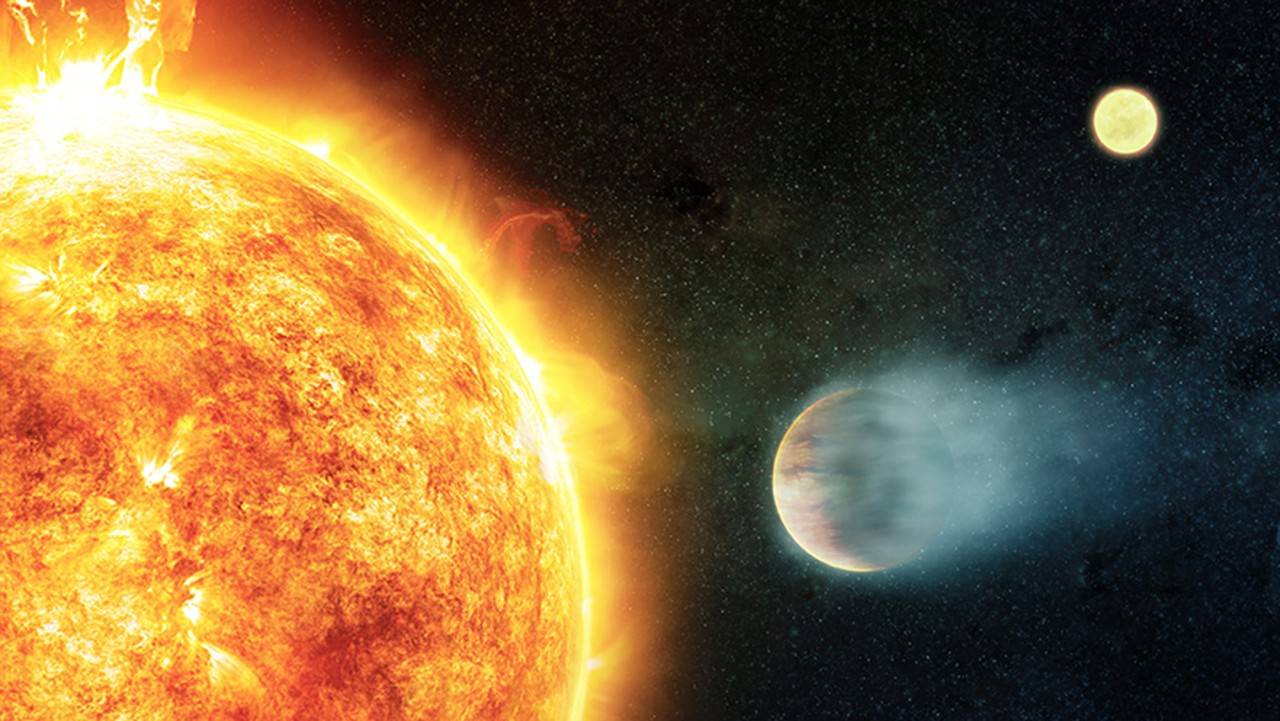Newfound 'hot Jupiter' exoplanet celebrates New Year's every 5 days
The planet discovered by NASA's TESS is a scorcher and whips around its star in under five days.

Still suffering from a New Year hangover? How would you feel doing it all again in less than a week? If you lived on a newly-discovered exoplanet, you'd have to do just that: Astronomers have spotted a planet three times the size of Jupiter orbiting a rapidly-spinning dwarf star around 530 light-years from Earth that celebrates a trip around its sun every five days!
This newfound exoplanet, designated TOI-778 b, is an example of a so-called "hot Jupiter," a world similar to our solar system's largest planet, the gas giant Jupiter, but located in extreme proximity to its star. This proximity gives rise to extreme conditions such as surface temperatures hot enough to vaporize iron and orbits of under ten Earth days.
This particular hot Jupiter orbits its star TOI-778 at a distance of around 5.6 million miles (9 million kilometers). This is much closer than even our solar system's innermost planet Mercury is to the sun at approximately 29 million miles (46 million km) away from our star.
Related: Mysterious 'hot Jupiter' planets can form quickly or slowly, Gaia spacecraft reveals
Exoplanet TOI-778 b has a radius of 1.4 times that of Jupiter and is approximately 2.8 times more massive than the gas giant. TOI-778 b orbits its host every 4.6 days and has an estimated surface temperature of around 2240 degrees Fahrenheit (1,500 Kelvin or 1227 degrees Celsius).
The planet's parent star dwarfs our own sun, measuring around 71% larger and possessing 40% more mass than our star. TOI-778 is also a rapid rotator, spinning at around 90,000 miles per hour (40 kilometers per second). The 1.95 billion-year-old star is under half the age of our 4.6 billion-year-old sun and has an estimated surface temperature of 11,600–11,780 degrees Fahrenheit (6,700–6,800 K).

TOI-778 b was spotted by astronomers led by University of Southern Queensland scientist Jake T. Clark using NASA's Transiting Exoplanet Survey Satellite (TESS). Conducting a survey of around 200,000 nearby stars, TESS has thus far revealed over 6,000 candidate exoplanets referred to as TESS Objects of Interest (TOI).
Get the Space.com Newsletter
Breaking space news, the latest updates on rocket launches, skywatching events and more!
Of these TOI, 282 have been confirmed as exoplanets thus far, joining a catalog of over 5,000 known planets outside the solar system.
Clark and his team spotted this new hot Jupiter by spotting a dip in the light output of TOI-778 caused as the planet crosses or "transits" the face of its parent star from our perspective here on Earth. The planetary nature of TOI-778 b was confirmed by follow-up investigations by ground-based telescopes and taking measurements of the system's velocity.
Clark and his team also found that the orbit of TOI-778 b is close to being aligned with the stellar equator of its dwarf star. They believe that the planet came to this position by sedately migrating through the disk of its host star TOI-778 rather than reaching this point via a chaotic process.
"TOI-778 b joins a cohort of other hot Jupiters with well-aligned orbits, suggesting that disk migration is the likely cause of their evolution to their current positions," Clark and his co-authors remark in the paper.
The team's research is published on the paper repository ArXiv.
Follow us on Twitter @Spacedotcom or on Facebook.
Join our Space Forums to keep talking space on the latest missions, night sky and more! And if you have a news tip, correction or comment, let us know at: community@space.com.

Robert Lea is a science journalist in the U.K. whose articles have been published in Physics World, New Scientist, Astronomy Magazine, All About Space, Newsweek and ZME Science. He also writes about science communication for Elsevier and the European Journal of Physics. Rob holds a bachelor of science degree in physics and astronomy from the U.K.’s Open University. Follow him on Twitter @sciencef1rst.
-
rod "Clark and his team also found that the orbit of TOI-778 b is close to being aligned with the stellar equator of its dwarf star. They believe that the planet came to this position by sedately migrating through the disk of its host star TOI-778 rather than reaching this point via a chaotic process. "TOI-778 b joins a cohort of other hot Jupiters with well-aligned orbits, suggesting that disk migration is the likely cause of their evolution to their current positions," Clark and his co-authors remark in the paper."Reply
That is very interesting, a hot Jupiter that *sedately* migrated inwards to its host star.
ref - Spinning up a Daze: TESS Uncovers a Hot Jupiter orbiting the Rapid-Rotator TOI-778, https://arxiv.org/abs/2212.08242, 16-Dec-2022.
My observation. Concerning disk migration scenarios to explain the origin of hot jupiters like TOI-778 b, the 18-page PDF report states: "It therefore seems most likely that TOI-778 b sedately migrated through its host’s disk, rather than reaching its current location through more chaotic means. Indeed, with a low obliquity angle and a stellar age of ~ 2 Gyr, we can rule out migration mechanisms such as high-eccentricity, planet-planet scattering, Kozai–Lidov tidal and secular chaos migrations (Masset & Papaloizou 2003; Nagasawa et al. 2008b; Dawson & Johnson 2018). Figure 9 shows the planetary obliquity as a function of host star temperature with TOI-778 b and the sample of known hot Jupiters with obliquity measurements. From Figure 9, TOI-778 b joins a cohort of other hot Jupiters with well-aligned orbits, suggesting that disk migration is the likely case of their evolution to their current positions."
My note. Properties for this hot jupiter are listed in the PDF report: "Table 3. Astrophysical parameters for TOI-778 b as derived by Allesfitter. Priors are shown as uniform U(a,b) or normal N(nu, sigma). Parameters used for the transit and radial velocity fits that are not located in this table can be found in Table 4."
My note. Exactly where TOI-778 b initially formed in the postulated, early protoplanetary disc, and how far it *sedately* migrated inwards to its present position ~ 0.06 au, I did not find shown or how long the calm migration lasted. -
spacejayk That's a great question Rod. I'm Jake, the lead author for this discovery. The short answer is, I didn't include the hypothetical migration time in the paper as there's just so much to write about and not enough time! There is a lot that needs to be considered when calculating the migration time of planets such as TOI-778 b. These considerations include hypothesising where and how far the protoplanetary disk was during TOI-778's (the star) formation, where TOI 778b was located in that disk etc. Sadly, there's no straight-forward answer, as numerous simulations would need to be done to properly estimate these properties.Reply
However, it could be done and I would be excited by seeing the results of such a simulation :) Thanks again for your interest in TOI-778 b Rod!
rod said:"Clark and his team also found that the orbit of TOI-778 b is close to being aligned with the stellar equator of its dwarf star. They believe that the planet came to this position by sedately migrating through the disk of its host star TOI-778 rather than reaching this point via a chaotic process. "TOI-778 b joins a cohort of other hot Jupiters with well-aligned orbits, suggesting that disk migration is the likely cause of their evolution to their current positions," Clark and his co-authors remark in the paper."
That is very interesting, a hot Jupiter that *sedately* migrated inwards to its host star.
ref - Spinning up a Daze: TESS Uncovers a Hot Jupiter orbiting the Rapid-Rotator TOI-778, https://arxiv.org/abs/2212.08242, 16-Dec-2022.
My observation. Concerning disk migration scenarios to explain the origin of hot jupiters like TOI-778 b, the 18-page PDF report states: "It therefore seems most likely that TOI-778 b sedately migrated through its host’s disk, rather than reaching its current location through more chaotic means. Indeed, with a low obliquity angle and a stellar age of ~ 2 Gyr, we can rule out migration mechanisms such as high-eccentricity, planet-planet scattering, Kozai–Lidov tidal and secular chaos migrations (Masset & Papaloizou 2003; Nagasawa et al. 2008b; Dawson & Johnson 2018). Figure 9 shows the planetary obliquity as a function of host star temperature with TOI-778 b and the sample of known hot Jupiters with obliquity measurements. From Figure 9, TOI-778 b joins a cohort of other hot Jupiters with well-aligned orbits, suggesting that disk migration is the likely case of their evolution to their current positions."
My note. Properties for this hot jupiter are listed in the PDF report: "Table 3. Astrophysical parameters for TOI-778 b as derived by Allesfitter. Priors are shown as uniform U(a,b) or normal N(nu, sigma). Parameters used for the transit and radial velocity fits that are not located in this table can be found in Table 4."
My note. Exactly where TOI-778 b initially formed in the postulated, early protoplanetary disc, and how far it *sedately* migrated inwards to its present position ~ 0.06 au, I did not find shown or how long the calm migration lasted. -
rod Reply
I love exoplanet studies and use these two sites for exoplanets and properties. MS ACCESS DB, reports and MS Excel stats too.spacejayk said:That's a great question Rod. I'm Jake, the lead author for this discovery. The short answer is, I didn't include the hypothetical migration time in the paper as there's just so much to write about and not enough time! There is a lot that needs to be considered when calculating the migration time of planets such as TOI-778 b. These considerations include hypothesising where and how far the protoplanetary disk was during TOI-778's (the star) formation, where TOI 778b was located in that disk etc. Sadly, there's no straight-forward answer, as numerous simulations would need to be done to properly estimate these properties.
However, it could be done and I would be excited by seeing the results of such a simulation :) Thanks again for your interest in TOI-778 b Rod!
The Extrasolar Planets Encyclopaedia (exoplanet.eu)
NASA Exoplanet Archive (caltech.edu)









